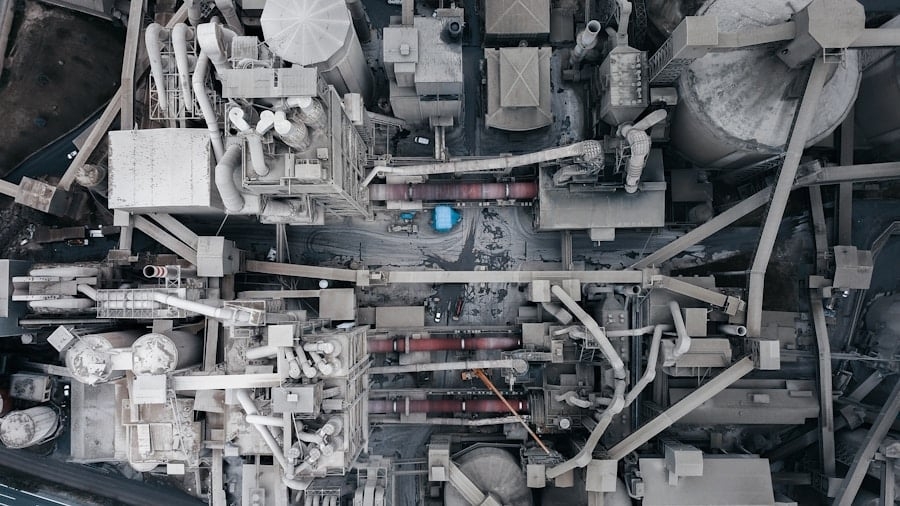Waste-to-energy (WtE) technologies represent a pivotal intersection of waste management and energy production, addressing two pressing global challenges: the growing volume of waste and the increasing demand for sustainable energy sources. These technologies convert municipal solid waste into usable forms of energy, such as electricity, heat, or fuel, through various processes including combustion, anaerobic digestion, and gasification. The concept of WtE is not merely a method of waste disposal; it is a transformative approach that seeks to extract value from waste materials while simultaneously reducing landfill use and greenhouse gas emissions.
The evolution of WtE technologies has been driven by the need for more sustainable waste management practices and the quest for renewable energy sources. As urban populations expand and consumption patterns shift, the amount of waste generated continues to rise, leading to significant environmental concerns. Traditional waste disposal methods, such as landfilling and incineration without energy recovery, are increasingly viewed as inadequate.
WtE technologies offer a solution by converting waste into energy, thus contributing to a circular economy where resources are reused and repurposed rather than discarded.
Key Takeaways
- Waste-to-energy technologies are essential for converting waste into usable energy, reducing environmental impact and promoting sustainability.
- Current challenges in waste-to-energy technologies include high capital costs, public perception, and regulatory hurdles.
- AI plays a crucial role in transforming waste-to-energy technologies by optimizing processes, improving efficiency, and reducing operational costs.
- Advantages of AI in waste-to-energy technologies include real-time monitoring, predictive maintenance, and enhanced decision-making capabilities.
- Case studies of AI implementation in waste-to-energy facilities demonstrate improved operational performance, reduced downtime, and increased energy production.
Current Challenges in Waste-to-Energy Technologies
High Capital Investment
One of the primary obstacles is the high capital investment required for the construction and operation of WtE facilities. The initial costs associated with building advanced waste processing plants can be substantial, often deterring municipalities and private investors from pursuing these projects.
Financial Uncertainty
The financial viability of WtE plants is closely tied to fluctuating energy prices and regulatory frameworks, which can create uncertainty for stakeholders.
Waste Composition Variability
Another significant challenge is the variability in waste composition. Municipal solid waste can vary greatly in terms of its physical and chemical properties, influenced by factors such as seasonality, local consumption patterns, and recycling rates. This variability can complicate the operation of WtE facilities, as different types of waste require different processing techniques to optimize energy recovery.
Role of AI in Transforming Waste-to-Energy Technologies

Artificial intelligence (AI) is emerging as a transformative force in the field of waste-to-energy technologies. By leveraging advanced algorithms and machine learning techniques, AI can enhance the efficiency and effectiveness of WtE processes in several ways. One of the most promising applications of AI in this domain is in the optimization of waste sorting and processing.
AI-powered systems can analyze vast amounts of data from waste streams to identify patterns and improve sorting accuracy, ensuring that recyclable materials are separated from non-recyclables before they enter the energy recovery process. Furthermore, AI can play a crucial role in predictive maintenance for WtE facilities. By utilizing sensors and data analytics, AI systems can monitor equipment performance in real-time, predicting potential failures before they occur.
This proactive approach not only minimizes downtime but also reduces maintenance costs and extends the lifespan of critical machinery. The integration of AI into operational workflows can lead to more streamlined processes, ultimately enhancing the overall efficiency of waste-to-energy systems.
Advantages of AI in Waste-to-Energy Technologies
The integration of AI into waste-to-energy technologies offers numerous advantages that can significantly improve operational efficiency and energy recovery rates. One key benefit is enhanced decision-making capabilities. AI systems can process large datasets quickly, providing operators with actionable insights that inform strategic decisions regarding waste processing and energy generation.
For instance, AI can analyze historical data on waste composition and energy output to optimize operational parameters, leading to improved energy recovery rates. Moreover, AI can facilitate better resource management within WtE facilities. By accurately predicting energy demand and adjusting operations accordingly, AI can help ensure that energy production aligns with consumption patterns.
This dynamic approach not only maximizes energy recovery but also minimizes waste generation by optimizing the use of available resources. Additionally, AI-driven analytics can support compliance with environmental regulations by monitoring emissions and other environmental impacts in real-time, allowing operators to make necessary adjustments promptly.
Case Studies of AI Implementation in Waste-to-Energy Facilities
Several case studies illustrate the successful implementation of AI technologies in waste-to-energy facilities around the world. One notable example is the use of AI at a WtE plant in Sweden, where machine learning algorithms were employed to enhance waste sorting processes. By analyzing data from cameras and sensors installed throughout the facility, the AI system was able to identify different types of materials with remarkable accuracy.
This improved sorting efficiency led to a significant increase in the recovery of recyclable materials, thereby reducing contamination rates and enhancing overall energy output. Another compelling case study comes from a facility in Germany that integrated AI-driven predictive maintenance systems into its operations. By utilizing machine learning algorithms to analyze equipment performance data, the facility was able to predict potential failures before they occurred.
This proactive maintenance approach resulted in reduced downtime and lower maintenance costs, ultimately leading to increased operational efficiency. The success of this implementation demonstrated how AI could transform traditional maintenance practices into more data-driven strategies that enhance facility performance.
Future Potential of AI in Waste-to-Energy Technologies

Autonomous Systems for Efficient Operations
One area ripe for exploration is the development of autonomous systems capable of managing entire WtE facilities with minimal human intervention. These systems could leverage real-time data to optimize every aspect of operations, from waste sorting to energy generation, creating a more efficient and responsive WtE ecosystem.
Integrating WtE into Urban Sustainability Initiatives
Additionally, as cities increasingly adopt smart waste management solutions, AI will play a critical role in integrating WtE technologies into broader urban sustainability initiatives. For instance, AI could facilitate real-time monitoring of waste generation patterns across urban areas, enabling municipalities to optimize collection routes and schedules while maximizing recycling efforts.
Towards Sustainable Urban Environments
This holistic approach could lead to more sustainable urban environments where waste is viewed not merely as refuse but as a valuable resource for energy production.
Ethical and Environmental Considerations in AI-driven Waste-to-Energy Solutions
While the integration of AI into waste-to-energy technologies presents numerous benefits, it also raises important ethical and environmental considerations that must be addressed. One primary concern is the potential for job displacement as automation becomes more prevalent within WtE facilities. As AI systems take on roles traditionally performed by human workers, there is a risk that employment opportunities may diminish, particularly for those in lower-skilled positions.
It is essential for stakeholders to consider strategies for workforce retraining and upskilling to ensure that workers are equipped for new roles within an increasingly automated industry. Environmental considerations also play a crucial role in the discourse surrounding AI-driven WtE solutions. While these technologies aim to reduce landfill use and greenhouse gas emissions, it is vital to ensure that they do not inadvertently create new environmental challenges.
For example, the combustion process used in many WtE facilities can produce harmful emissions if not properly managed. Therefore, it is imperative that AI systems are designed with robust monitoring capabilities to ensure compliance with environmental regulations and minimize negative impacts on air quality.
The Path Forward for AI in Waste-to-Energy Technologies
The path forward for AI in waste-to-energy technologies is filled with promise and potential challenges alike. As we continue to explore innovative solutions for managing waste and generating sustainable energy, it is crucial to foster collaboration among stakeholders across sectors—government agencies, private companies, researchers, and communities—to create a comprehensive framework for implementing these technologies responsibly. By prioritizing ethical considerations and environmental stewardship alongside technological advancement, we can harness the power of AI to transform waste into valuable resources while contributing to a more sustainable future for all.
By utilizing AI-powered chatbots and virtual assistants, companies can provide personalized and efficient customer service, ultimately enhancing the overall shopping experience. To learn more about the impact of conversational commerce, check out this article.
FAQs
What is waste-to-energy technology?
Waste-to-energy technology is the process of generating energy in the form of electricity or heat from the primary treatment of waste. This technology helps in reducing the amount of waste that goes to landfills and also produces renewable energy.
How is AI transforming waste-to-energy technologies?
AI is transforming waste-to-energy technologies by optimizing the process of waste management, improving the efficiency of energy production, and enhancing the overall operational performance of waste-to-energy plants. AI can also help in predicting equipment failures and optimizing the sorting and processing of waste materials.
What are the benefits of AI in waste-to-energy technologies?
The benefits of AI in waste-to-energy technologies include improved efficiency in waste management, increased energy production, reduced operational costs, better resource utilization, and enhanced environmental sustainability. AI can also help in making waste-to-energy processes more reliable and safer.
What are some examples of AI applications in waste-to-energy technologies?
Some examples of AI applications in waste-to-energy technologies include predictive maintenance of equipment, real-time monitoring and control of waste processing, optimization of energy production processes, and advanced sorting and recycling of waste materials. AI can also be used for data analysis and decision-making in waste-to-energy plants.
What are the challenges of implementing AI in waste-to-energy technologies?
Challenges of implementing AI in waste-to-energy technologies include high initial investment costs, the need for specialized technical expertise, data privacy and security concerns, and the potential resistance to change from traditional waste management practices. Additionally, integrating AI into existing waste-to-energy infrastructure can be complex and require careful planning.

